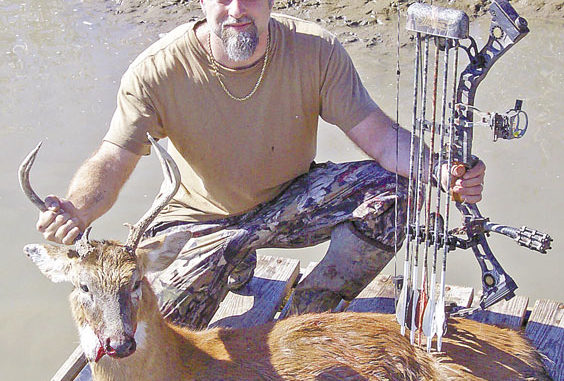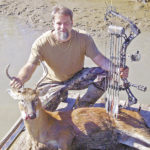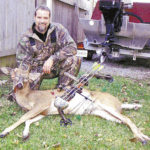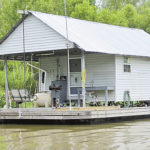
Park yourself on Atchafalaya Delta WMA opening morning of deer season, and chances are quite good you’ll be eating venison for a few weeks.
There is a place down at the mouth of the Atchafalaya River known to many locals as “The Delta.” This is not your average hardwood, highland hunting grounds. This place is totally different.
This is South Louisiana, and the environment is wet, muddy and notoriously foggy. Down here, hip boots and knee boots are king, fighting falling tides and the steady flow of offshore work boats is the norm, and prop-snagging sandbars are everywhere. If you’re ready for a different type of deer hunting and are looking for a little excitement in the process, do yourself a favor and take a trip to the Atchafalaya Delta WMA.
Getting there
First and foremost, you are going to need a boat, a map and a GPS. Anyone venturing to The Delta who hasn’t been should never make the trip without a map and a GPS. The GPS will serve a few purposes, such as helping you find your way downriver to the WMA, tracking your path at all times so you know where you can drive the boat and not run aground, and most of all, getting you back to camp when the blinding fog rolls in.
If you hunt The Delta long enough, this is something you will encounter. This management area lies 25 miles south of Berwick. Local access to the Atchafalaya River, which leads to the WMA, can be found at the boat launch at the end of River Road in Berwick. Once you leave the landing, head down the river for 25 miles.
When you get to the mouth of the river, the WMA will be on your right, just before entering Atchafalaya Bay. There is a large primitive campground with an outhouse provided. If you have a floating camp, you can also bring it down to The Delta and moor it there for six months a year. Your camp-boat will have to have a sewer-disposal system that meets all standards of the state, and must be approved by the local Health Department. Permits for such camps can be applied for in July by contacting the Atchafalaya Delta office in New Iberia at 337-373-0032.
Hunting equipment
Hunting at The Delta can be somewhat out-of-the-norm when it comes to bowhunting for deer. If you show up with a climber on your back expecting to scurry 20 feet up an oak tree overlooking scattered acorns on the ground, you’ll be quite disappointed. This is marsh country, and wax-myrtle bushes dominate the landscape. Down here, small tripods and short, light ladder stands are the weapons of choice.
Although you can use climbers in certain spots (some people kill deer regularly out of them down there), you are severely limited to where you can set up. Tripods and ladder stands allow you to set up pretty much anywhere. It takes only a small myrtle bush to set up a 6-foot ladder stand; yes, you heard me right — 6 feet. When you put a man 6 feet off the ground with a whitetail deer in front of him at 10 yards, things start to get exciting real fast. Thats one thing I’ve always liked about this place — you’re up close when the kill happens.
This is also a place where ground blinds work well. The terrain and environment allow them to blend in perfectly, and the lack of climbable trees makes them a must-have in your Delta arsenal.
Another tool that is a necessity when hunting in this environment is a well known and loved device known as a Thermacell. This place is a mosquito paradise, and the Thermacell is a welcome defense. Add in a Bug Tamer suit, and you’re now ready for The Delta’s insect onslaught.
Accessing the islands
Once you reach the campground and you have your camp set up, you can access the Big Island via the cul-de-sac on the southern end of its west side. Here you will find a safe place to anchor your boat, and DWF officials also have a sign-in box at this location.
There are two more access points farther north of this location known as Ditch No. 1 and Ditch No. 2, but access can be severely limited due to the sloughs silting in and lilies blocking the path.
If you’ve never hunted the Delta before, the cul-de-sac would be your best bet. Its coordinates are N29 27′ 20.2 x W91 19’ 16.7.
If you choose to hunt one of the many other islands, your access to them will be well-earned. Most of the locals have Pro-drives or Gator-Tails on small flat boats for running in the shallow waters that surround these islands. Even with these types of motors and boats, there is still no guarantee of you getting out once dark arrives and you’re back at the boat.
The tide can drop fast here, and every year many seasoned veterans struggle to get out once this happens. Sometimes they wind up sleeping in their boats or catching a ride with someone else while leaving their boat out there until the tide rises again.
A safe and sure way to access these islands and not have these types of problems is to anchor your boat out in the river off to the side, out past the sandbar, and push a pirogue the rest of the way to the islands. This way, you’ll never get stranded as the tide drops.
One important thing to remember when doing this is to leave the running lights on in your boat, so passing offshore boat traffic will be aware of your boat’s position, slow down accordingly and not sink your boat. Also, make sure you anchor the boat with a rope on the front and back, securing it in a constant position to directly face the oncoming wake that larger boats create.
Hunting strategies
Once you’ve made it onto one of the islands, it’s time to hunt. The Big Island, as it’s called, has a shorter season than the smaller islands, so make sure you’re up to par with the current year’s regulations before venturing south.
Looking for a place to hunt can be overwhelming in this type of environment. A sure bet is to set up along the edges of the islands where the marsh that surrounds them meets the myrtle bushes and the higher, dryer ground. The deer like to bed out in the tall marsh grass, and then at dark, make their way onto the main part of the islands to feed. Set yourself up on trails, and cut them off midway.
Early in the season, look for spots out in the marsh with marsh cowpeas growing. If you find a spot with these, hang your stand because you’ve found a main early season food source, and the local deer love them.
There is also a small-blade grass called alligator weed; this is a major food staple for the deer in this area as well. Locating large patches of this type of grass with all of its tops nipped off is a sure path to Delta success.
As we all know with deer hunting, there are never any guarantees, but if you apply some of this basic knowledge to your hunting endeavors at The Delta, you’ll greatly increase your odds of coming home with venison in the cooler.
Do yourself a favor and treat yourself to the unique deer hunting experience that the Atchafalaya Delta WMA has to offer. This place is a true South Louisiana gem.





